 Curt and Dr. Gathright Curt and Dr. Gathright Dr. John Gathright was an author and motivational speaker, not a tree climbing expert. He wrote a book about pursuing your dreams, and at one of his book signing events, he was approached by a woman. Speaking from her wheel chair, Toshiko Hikosaka told him of her dream to climb the world’s largest tree and that she wanted him to help her. He was not a tree climber and had no idea how to climb such a tree, but he wanted to help her achieve her dream. Three years later, Gathright and Hikosaka reached the top of a giant sequoia. At 63 years old, she was the first paraplegic to climb a tree to this height. Her climb that day culminated in triumph, wonder and exhaustion. They spent the night in the top of that 243-foot tall tree, on the branches, under the stars. Just as that day in the bookstore had set the ball rolling for their 3-year journey, the climb to the top of the sequoia was the beginning of the next chapter. Upon returning to Japan, demand for Gathright’s tree climbing adventures inspired him to cut his own path forward. Given there were no tree climbing schools in the country at that time, he had to start at the very beginning. It was a delight for me to be able to attend a presentation of Dr. Gathright recently. He is a pioneer in using recreational tree climbing in therapeutic and rehabilitation programs, and I have been inspired by his work for a number of years. To hear him tell his story of the legwork he had to go through was amazing. Sometimes It Is About The Numbers He had to find research that supported his idea of establishing tree climbing as an effective and legitimate form of therapy. No research existed at that time, therefore he realized his next course of action was going to have to be the pursuit of his PhD studying and testing his hypothesis. His doctoral thesis looked at the physiological and physical differences in individuals between their climbing living trees and climbing a concrete structure. In both instances, participants were climbing to elevated heights and performing similar tasks. In analyzing the data, there were clear differences between the 2 experiences. When climbing trees, participants experienced less pain and fatigue, experienced greater vitality and clarity of mind, and reported feeling a greater feeling of self-worth versus when they were climbing the concrete structure. Tree climbing had produced an increase in positive emotions and reduction in negative emotions. His further studies revealed and measured reductions in participant levels of stress, tension, anxiety, depression, and anger after climbing trees. Not only did his research show the positive effects of tree climbing, it revealed that it wasn’t simply the climbing that was providing the benefit. There was a marked enhancement of the effects when the participants were climbing trees. Gathright had provided the scientific basis behind his TreeHab and Tree Therapy programs. Meet Your Therapist My first ascent of a tall tree early in my career had a profound impact on me physically and mentally. My muscles enjoyed the physical exertion, but I was exhausted. I was energized by the height I had reached, at the same time nervous. Through all of the hormones flushing through my body, I found mental clarity and focus. I was energized, yet I was at peace. I never measured the effects to confirm in what ways and by how much climbing trees changed me, yet I walked away from that climb relaxed and inspired. And every climb since. Over 20 years later, I came across the research of Dr. John Gathright that identified and quantified the effects of climbing trees that I had personally experienced. From its origins in 2000, TreeHab has worked with thousands of children with physical disabilities and emotional trauma. Gathright and Tree Climbing Japan have helped over 300,000 people of all abilities discover their inner tree-climber. As I listened to him share his stories of people he has worked with over the years, I was reminded of those who have touched me during my journey thus far. Tree Climbing Touches Lives I am involved with tree a climbing program for urban youth and people who do not have the resources to leave the concrete and asphalt landscape at will. Counselors and therapists utilize our climbing experience in their dealings with children facing emotional trauma, such as that related to the loss of a parent. It was interesting to hear him speak of programs developed for people with autism and ADHD. While the experience and benefits of tree climbing have a profound impact on these participants, it appears that TreeHab is also having a promising impact on breaking down the stigmas associated with them in his community. I have seen the benefits first hand in dealing with a variety of people from all walks of life and backgrounds. While the majority of our climbers may not fall into any of these categories, every one of us benefits from the same effects that tree climbing provides. His words brought into focus for me that we each have our own inhibitions, insecurities, and unique qualities. Each of us may be at a different point in our journey through life, come from different backgrounds and face our own challenges; but, every one of us can reap the benefits of time in the trees.
0 Comments
Through this past year, the vast majority of climbers returned to the ground with a sense of accomplishment, feeling of pride, boost in self-confidence, and a big smile on their face. We met parents who were supportive of their children, speaking with words of love and encouragement. There were participants who overcame their trepidation and ended up excelling and enjoying their time above the ground. A number of children and young adults had the exciting opportunity to participate in an activity alongside their parents and grandparents. With so many fantastic memories and wonderful people, I was tempted to put together a year-end video recap of the year. We were able to capture many nice images of climbers, but there are too many for us to make a video with a realistic time length. In this period of reflection, I am inspired to share your pictures in a series of videos related to our experiences with trees and tree climbing. Inspired by Robert Fulgham's book All I Really Need to Know I Learned in Kindergarten... and our interactions together, I created this video to share a few of the lessons trees have taught me throughout my journey thus far. Your day in the trees may have been captured in this video. If not, I hope you will keep an eye out in the coming months as I cycle through as many of the images as I can in upcoming videos. Other images will grace our website pages and posts on Facebook and Instagram. A guided, mindful walk in the woods
This year, my wife and I spent a few weeks camping in North Dakota. The majority of our hikes took us through remote wilderness areas where we spent hours without seeing another person. There were a number of hours spent where we heard no sound of human civilization. No road traffic. No airplanes. Recently we spent a few days hiking trails in some of our State Parks and natural areas from Milwaukee to Door County. It rained much of our trip, which meant we again found ourselves alone on most of the trails we walked. For the past few years I have been focussed on improving the quality of the time I spend outdoors and the associated benefits. Simply looking at pictures of nature can have positive and measurable impacts on our well-being. Walking into a forested area is even more powerful in part because you are breathing in essential plant compounds. But, is there a way I can improve my experience? I have been amazed at how much impact these benefits can have, and I created the following video to share part of this journey with you. You might feel better just watching it! 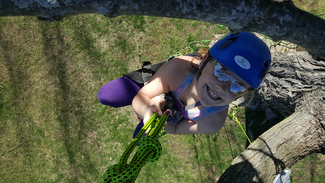 Feeling stressed? Looking to escape? Need a break from the demands for your time? It sounds like you could benefit from a change in altitude. This past winter, Jen and I spent time on a tiny island off the coast of southern Florida. The 10-acre island had a handful of cottages, a walking trail, a restaurant, and a few chairs down by the water. No television, spotty cell service, and limited Wi-Fi access. We rented a skiff one day to get to a neighboring island to enjoy a desolate beach. We saw more dolphins, sharks and stingrays than people that day. The week gave us time to talk, sit, read, write, nap, and enjoy our time together. It was quiet. We were relaxed. Trips like these can be a great way to decompress and recharge. They are a small part of the life component in the “work-life balance.” Returning Home Whether it is during your return flight, the moment you reclaim your suitcase or walk through your front door, there is probably a specific moment where your mind jumps back into your responsibilities and your To Do list. Vacation is over. Even if that line for you is blurred more than the picture I describe, and I hope it is, there comes a time when you find yourself back in your daily and weekly routine. It is a feeling similar to wading across a stream. You start by heading into the water, eventually finding yourself in the current. You are focused on heading in the direction you’ve set your sights on, yet not fully aware of the gradual increase in energy you are expending to keep your footing and head above water. At times, the current may pull you off course slightly. Your drive gets you to the other side, but you are exhausted. Wouldn’t it be nice to take a break when the current of life seems to be unrelenting? Fast-forward to the next vacation? Thankfully the current fluctuates. Some days are easier and more productive, others are more challenging. For you, it may seem like months before the current lets up. It might not let up until summer break. Or perhaps the slow-season in your industry, as in mine, doesn’t come until winter. Thankfully, not even 15 feet above the ground, lies the same peaceful escape. Days Like These I do not like to wish my life away. It will pass by soon enough. That’s why I love having the ability to change my altitude when stress seems to be building. It only takes an hour or two out of my day to climb to a different level, and the benefits are often as great as a week in the tropics. Up there, your mind will find peace. It’s as if the worries of ground life are restrained by gravity. As your attention turns towards the mechanics of climbing the rope, your mind is left with little room for outside worries. All of that weight falls from your shoulders relatively quickly. By the time I reach my resting branch, it’s as if I flew back to the island. The sounds of the palm fronds in the breeze and ocean waves lapping against the mangroves are replaced with the rustle of the oak leaves unfurling ahead of the upcoming growing season. An assortment of birds singing and squirrels chirping help me connect to the present moment. My senses are consumed with an appreciation for the unique perspective from where I sit. The tree holds and protects me from the chaos below. Time is of no concern when you spend time in a tree. The breeze, movement of the leaves, and connection with Nature’s energy will consume you. The change in altitude brings with it a change in attitude. This all happens without intentional thought. You enter tree-time as if entering a 3-dimensional field of energy. You can climb trees for something to DO, but most of us discover it is actually a place to BE. Grounded When you return to the ground and get your land legs back, you begin to realize your worries and demands are waiting patiently. One by one, you pick them up and head back into your daily routine. Nature is in no rush. The trees carry on about their business. They will await your return. Most of our Rec Climbs are hosted by municipal recreation departments. More times than not, you will find these climbs listed in the youth section of their activity guides, which may give the impression that tree climbing is for children. In reality, tree climbing is enjoyed by people of all ages. Tree climbing is for people who want to stay young at heart and of healthy mind. Come out and enjoy the benefits of a change in altitude. Two of the most amazing trees you could ever hope to meet are General Sherman and Methuselah. In the same day, you can visit both the largest tree and the oldest tree on the planet.
The General Sherman tree stands prominently in the Giant Forest in Sequoia National Park. Methuselah grows about 70 miles to the north, in the Ancient Bristlecone Pine Forest. General Sherman is a 2,000 year old sequoia that reaches 275’ towards the sky.. It is the largest known tree on the planet, measured by volume. You may find it difficult to reach the first branch, given it emerges at 130’ above the ground. To put this in perspective, there are only a few trees in Wisconsin which surpass 150’ in height. It is very likely every tree you have come across in Wisconsin would not even reach the General Sherman tree’s lowest branch. With a trunk diameter of 36' across, the footprint of its trunk covers almost 1,000 square feet. How does that compare to the size of your house? Methuselah is about 4,850 years old, yet stands less than 50’ tall. The other measurements don’t mean much when you allow its age to sink in. The Pyramids of Giza were built around the time Methuselah was turning 500 years old. What’s more, there is another bristlecone pine recently found to be about 5,060 years old. I have spent most my life visiting and interacting with trees, but the time I spent in the midst of particular trees is an experience I will never forget. These trees are in a class all to themselves. It’s as if they come from a different world and another time. There are other impressive trees to meet around the world, but we are fortunate to have incredible trees that are a little more accessible to us. Trees of Wisconsin The trees and forests of Wisconsin were cleared for agriculture or heavily logged in the late 1800’s and early 1900’s. Trees and forests are also removed for development and growing population. This means that the vast majority of the trees we come across today are less than 150 years old. For that reason, it is a pleasure to enjoy trees which pre-date European settlement. Some of our more notable trees reach heights over 150’ and ages near 450 years. Ancient and big trees tend to capture the imagination of many people. Because of this, the Department of Natural Resources keeps a list of Wisconsin Champion Trees, keeping track of the largest trees in our state. The list is searchable by species or County. I enjoy searching out these large trees. Calling attention to large and notable trees is important and plays a role in helping raise awareness and appreciation for the value of trees. In the end however, a tree’s measurements are only one aspect of its overall personality. What Makes a Tree Great? What is your favorite tree? Is there a tree that holds significance to you? Picture this tree in your mind. Is it a sugar maple your grandparents planted in their backyard? Do you pass this tree on your daily commute? Does it shade your house? Did you plant the tree in honor of a loved one? When I travel around Wisconsin, I consider the changes a tree has witnessed over the years. Some of the oaks we climb have been growing for 250-300 years. These trees were friends of the Menominee, Sauk, Ojibwe and other Native American tribes. They witnessed population growth as European immigrants continued to move into the area, and saw the territory achieve statehood in 1848. Do you enjoy any one of the numerous lone bur oaks across Wisconsin, with sprawling branches and rising from a field of corn? Have you looked up the trunk of an eastern cottonwood shooting towards the clouds like skyscraper? There are many majestic trees in the forests, fields and cities throughout Wisconsin. Connecting with trees gives me a feeling of place within history and time. With the future in mind, I plant trees to celebrate certain people and events in my life. They are a symbol of future growth and prosperity. They are a tribute to the legacy of my loved ones and connect me to future generations. Most trees will keep their stories to themselves. Those who take time to listen and observe, can draw upon the wisdom a tree has gathered during its time rooted in soil. We may not be able to run out to the Ancient Bristlecone Pine Forest this weekend, nor stroll through the Giant Forest after lunch; but, we have plenty of amazing trees in our Wisconsin landscapes that are awaiting your visit. I encourage you to spend time in a tree’s shade, whether during a hike or pausing beneath on a sunny day, and take time to listen and imagine the tales it could tell. At Treetop Explorer, we are fortunate to get up close and personal with some amazing trees. Check out our climb schedule and we’d love to introduce you! 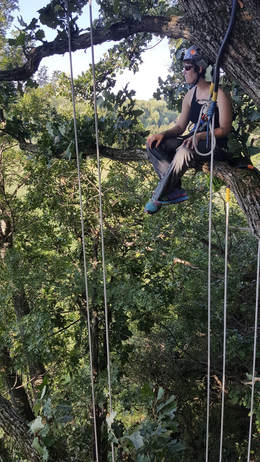 Who am I? Why am I the way I am? What factors have affected me through life which contributed to who I am today? These are questions I often ask myself. During a parent-teacher conference, my 3rd grade teacher told my parents that I always came in with a big smile on my face. I was a little too chatty, but she loved how happy I was. Who was that little boy? Is he still inside me today or did I chase him off? Connecting With Kids Today I am sitting near the top of The First. This white oak has become a trusted friend and mentor over the past few years. The First is our primary climbing tree at camp. Sitting at the top, I am looking down on the cabins below. I have a clear line of sight to the swimming area where children will splash and play come summer. The backdrop to this end of camp is bright blue thanks to the clear sky and its reflection across the lake. This week we have 3rd graders in camp. This is likely the first time they have experienced life in the woods. They are introduced to wildlife, plants, minerals, sights, sounds, and smells that may not be part of everyday life in the city where they live. For most, this is the first time they have been away from mom and dad for an entire week. Sitting high above the children below, I am out of their line of sight. They are enjoying free play with each other. Digging in the dirt, building forts out of fallen branches, throwing a football, and singing songs. Their imaginations guide them. The First and I are relaxing and taking it all in. I am enjoying this youthful energy carried up to me in sounds of laughter and chatter. These sounds take me back. Connecting To Nature Can you remember what you were like in 3rd grade? It seems like when I was not in school, my brothers and I were playing outside. We had a huge open field behind our house and plenty of lakes and parks within walking distance. I remember field trips to the zoo, aquarium, planetarium, nature centers, and the Everglades. I do not recall what grade I was in, but one of our field trips took us into a mangrove swamp. Trudging through the knee-deep water, we used nets to skim the surface of the water and scoop up muck from the bottoms. We were collecting samples of the different types of animal life found in that ecosystem. I can still picture the sea cucumber we collected quite vividly. I remember the contrasting responses of “cool” and “gross” ringing above the hum of “oohs” and “eews.” Years after I scooped up that sea cucumber, new friends were introducing me to the excitement of repelling off cliffs and climbing rock faces. Hiking and camping were common weekend getaways during my years at college. Numerous lakes and rivers in the area provided the opportunity to fish, swim, and canoe. Is there a specific aspect of Nature you find yourself drawn to? For me, trees have piqued my curiosity. I find both comfort and a sense of excitement when I am spending time amongst trees. For whatever reason this connection exists, it is ultimately responsible for the direction my professional career has taken over the years. Reconnecting With Myself Spending personal time in nature is where I tap into pure and concentrated life energy. It is essential for health and well-being. Call it maturity or call it life, somewhere along the way, my focus on how I spent personal time gradually shifted. Commitments, responsibilities, and other demands for my time increased over the years. These impacted the amount of time I set aside for personal time, let alone that time being outdoors. I watched this shift over the years. What used to be something I did because I enjoyed it, like spending time in the garden pulling weeds and watering plants, was now viewed as a chore I have to tend to. As I considered the subtle change over the years, the innocence of the children below brought my younger self out of the mangroves and onto a nearby branch. My reflections back upon the beginning of my career allowed that young adult to join us. The three of us sit together. Looking at both of them, I realize they are still very much a part of who I am. We were each part of discovering who I am and determining the direction I would move forward. Our intentions were to make wise decisions that our future self would be inheriting. As a kid, I learned the correlation between healthy ecosystems and healthy organisms. I also knew the joy of spending time outdoors. I still have the same joy in my heart and have continued on the journey I envisioned at each age sitting before me. I am happy with my successes and know they would be proud of the man they have become. Spending these past few moments thinking about The First, listening to the children below, and spending time with my younger selves, I feel revitalized. My vision is clear. I remember who I wanted to be. Looking back, what were the experiences and memories that shaped you? Do you have a connection to nature and the outdoors that informs your values and choices? Do you want to be able to give those same experiences in the trees and forests to your own children and the next generation? You never know what experiences will become memories or even passions in our lives. The important thing is to get out, open our eyes, and follow our hearts. 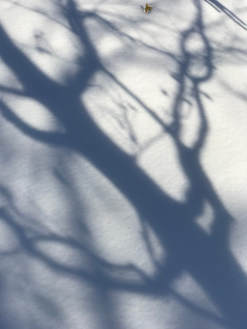 Hiking through Minooka Park recently to enjoy the fresh snowfall, I came across a young boy who was out for his first ride in the snow on his new fat tire bike. It looked like a lot of fun, although drastically different conditions than when I first learned to ride my bike. I got my first bicycle for Christmas; a purple Schwinn Sting-Ray with a banana seat. We lived in San Juan, Puerto Rico, so I was able to head right outside and learn to ride. I was ready to take on the world, or at least the street in front of our house per mom’s rules. I rode practically every day that winter with shorts, t-shirt and socks pulled up to my knees. A few years later, we were living in Miami, FL. Winters were a bit different as it got cold there. More like ‘chilly,’ given my perspective today as a Wisconsin transplant. Still, it was a season that actually brought a change in temperatures. There were days we could actually see our breath! I was mesmerized by the phenomenon. There were times I’d get light-headed and dizzy from exhaling for prolonged periods of time, just so I could see my breath. My parents continued their northerly migration, landing us in St. Louis as I headed into high school. Right before Thanksgiving that first year, we received our first snow flurries of the season. That is my earliest memory of enjoying snow falling from the sky. The moment I stepped off our front porch, I was immersed in the shower of snowflakes. I watched flakes land on my new winter gloves. I was able to focus on the details and designs of those flakes. The tiniest of details. I was amazed. I had never looked at one that close. To this day, I feel the same sense of excitement when I see the lightest of flurries. That was then, and this is now In the years between then and now, discovering winter has provided many exciting experiences for me. This morning, the sun is casting the shadows of our maple trees’ branches across the driveway and snow covered landscape beneath. These same trees shield us in the summer as they shade our backyard sitting area. Covered with snow however, another personality is on display. Taking a stroll through the garden, I am able to appreciate the time I’ve spent planning and adding landscape details to provide interest in each season. Details that draw me outside regardless of temperature. After all, these details are only visible during the winter. Arborvitae and coneflower seed heads frosted with snow. Little bluestem and lichens providing a splash of color. In winter I spend more of my work day sitting behind my desk than I do sitting in the branches. Your work hours are probably similar. Because of this, we miss most of the daylight. If we do get a view of daylight, the color spectrum is noticeably void of the colorful splashes of flowers and greens of summer. That’s why I keep an eye out for when the sunshine calls. I do not want to let too many days go by without getting outside to enjoy the sunshine. I trust you too have been watching the daylight stretching longer as the days have progressed. Although it’s challenging, one of my winter tasks includes searching out new trees for climbing programs. Whether I call it work or not, at least it gets me outside during the week to enjoy the daylight and keep me connected with Nature. No matter how low the temperature, I cannot miss the opportunity to enjoy the sunny day ahead. Winter would not be as enjoyable if I simply hunkered down inside and waited for it to pass. Soon enough, we will return to the trees. We have many opportunities lined up for you to climb with us this spring. With the summer season set, I’m excited to announce that we will be climbing in a few new communities this summer. Fox Crossing, Kaukauna, and Waunakee dates have just been finalized! Climbing begins on April 14th, and registration is open at this time! Visit our climbing calendar for the details. I hope you can join us for one of them. 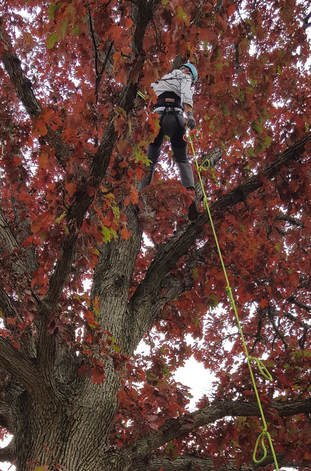 Fall is my favorite season. Tending to the final details in preparation for our upcoming Camping/Climbing weekend, I find myself trying to figure out what I enjoy most about this time of year. Part of the excitement is the anticipation scenic drives through the Wisconsin countryside. With each passing day, we the trees take a step closer to peak color. However, my love of fall goes far deeper than scenic drives, a trip to the apple orchard, and cooler weather. Fall overwhelms my senses as each one is stimulated simultaneously. The colors of fall are beginning to pop up around our area. The color contrast is striking when the yellows, oranges and reds of the leaves are set against the green grass and blue sky. The colors are further enhanced thanks to the lower angle of the afternoon sun. Fall’s approach is announced with the sound of crunching leaves beneath my feet, chatter of the chipmunks and squirrels preparing for the winter, and the sound of geese heading south overhead. The smoke from backyard campfires wafts throughout the neighborhood. The earthy smell of the fallen leaves during a stroll in the woods sends chills down my spine. I am tantalized by the feeling of cool breezes brushing against my skin. Inhaling the crisp autumn air, my thoughts turn to reflection and contemplation. 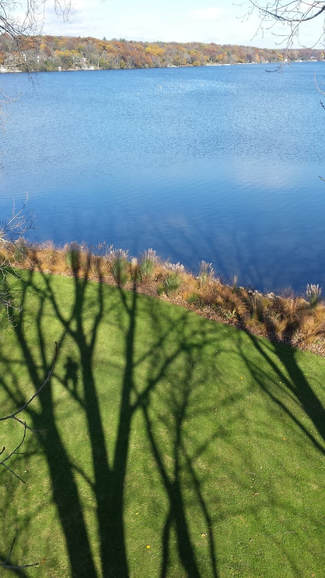 Nature’s Rhythm We experience a wide range of weather patterns in Wisconsin, many times in the same week and sometimes even the same day! It is this variability in the weather and the change of seasons that I enjoy. The rainy weather pattern we have seen over the past few weeks and warmer temperatures triggered an unwelcomed flurry of activity from mosquitoes, but they also provide a huge benefit to trees as they head into winter. Thanks to those rains, one piece of the puzzle is laid leading up to what is likely to be a season of optimal fall color in many areas. With summer fading away, this period of transition triggers a feeling of excitement for the one ahead and a sense of closure on the one we are leaving behind. I am particularly excited as fall is still my favorite time to be in trees. I spend time reflecting upon the experiences of the past year. I am tuned into Nature’s rhythm, which puts me at peace. I feel a spike in my creative energy as I look towards the future and begin identifying ways to enhance my life energy in the coming year. Falling Leaves & Climbing Trees Getting my feet off the ground and the freedom of being on rope heighten my sensory perception. Simple pleasures I enjoy on the ground are enhanced while climbing trees. Come fall, they turn into bursts of energy felt throughout my body. Laying on a branch in a sugar maple allows you to bask in the tree’s red-orange-yellow aura. Sitting within the pool of light emitted by the surrounding leafy mosaic, it is easy to get a sense of why John Muir referred to trees and forests as Nature’s temples and cathedrals. Your view is obscured when a tree is in leaf. The foliage acts as walls between the rooms and levels of your climbing tree and those of neighboring trees. As the balance of leaves covering the ground increases from those remaining on branches, your depth of visibility increases to reveal the structural beauty of scaffold limbs. The sound of crinkling leaves carries across the distances, enabling you to envision the playful nature of squirrels even if they are out of sight. If you sit long enough, the leaves may signal the approach of deer. It is a neat experience to sit above and watch grazing deer meander by without being alerted of your presence. Despite the lower temperatures, the physical nature of climbing warms your body. Even a slight hint of perspiration is enough to energize you when a cool breeze passes by. Once the leaves have fallen, you are able to enjoy shades of brown, gray, and black. You can focus your attention on the details and variety of leaf shapes strewn about below. The ground provides a canvas as the shadows cast by the trunks and branches convert the three-dimensional world into a dynamic line-drawing. Enjoying this abstract art work of shadows and leaves, you’ll eventually find your silhouette projected on the ground. The realization of looking down upon myself is a type of out-of-body experience that brings me back into the present moment and my sensory system back into check. 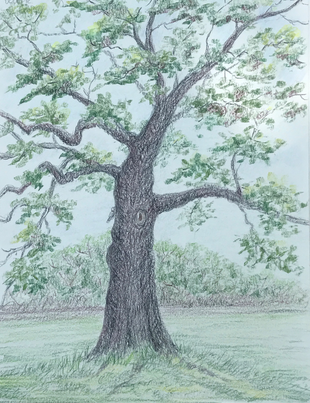 On a Friday evening in late August, I headed out early in order to get an hour of personal time in one of my favorite trees before I had to set up for the evening’s climb. As I pulled up I noticed a woman sitting at a picnic table beneath the tree. In order to install the ropes, I need to have people out of the area, so I was going to have to ask her to move. This tree and its nearby companion are a pair of mature white oaks that have a special presence about them. Their large size and branching structures are quite a contrast to the younger neighboring walnuts and hickories. It is no surprise to me that someone else enjoys time beneath these trees as I do. In walking up to her, she appeared to be at peace and had a positive energy about her. I paused for a moment with reservation given I had arrived early solely for the intent of spending personal time in the tree. I thought maybe I should hike a nearby trail and allow her to enjoy her time with the trees until it was time to set up for the climb. While these thoughts ran through my head, the woman turned and greeted me with a warm smile and cheerful, “hello.” In front of her a wooden flute lay on the table. With pencil in hand, it was apparent I had interrupted her in the middle of journaling. We were immediately engaged in a conversation about what I was up to, as I was carrying a colorful rope and wearing my climbing helmet. I was there to enjoy time in the tree. She was there to enjoy time under the trees. That was enough for us to form a bond. Bonding Under The Trees For the next hour, we shared stories from our lives. I found myself sharing topics I seldom discuss with anyone other than my closest friends and family. She talked about her life experiences and valued memories. Together, we enjoyed conversations about family, hobbies, life and dreams. The reason we had met was simply due our appreciation for the two trees above, which is why I think the conversation kept returning back to them. Together we found that their energy has provided comfort and aided in self-reflection in our both of our lives. I told her what the trees have meant to me for the 2 years I have been coming to visit. Some of my encounters were from above. I pointed out the branches which cradle my head as I lay back to gaze upon the branches and leaves above. I shared stories of climbers who had successfully challenged themselves at different places in the tree. She has been coming to these trees for many years. Journaling and playing her flute in their shade, she too has formed a bond with them. They have become close friends to the both of us. It was enjoyable to hear her perspective and memories of the trees. Given how private I am with my own journaling, I was touched when she opened her journal to me to share a story and a hand-drawn picture of the night’s climbing tree. With colored pencils she had captured the character of the tree in her drawing. Without ever climbing the tree, she noticed and had detailed some of my favorite branches. Two people from separate generations and backgrounds, yet we appreciated some of the same details of this amazing tree. Giving Them A Name I like to name trees once I get to know them. It was time to name these two oaks, which is what I was hoping the day’s climb would reveal to me. We name trees because they are living beings and companions, much the same as why we name pets. It is a display of respect, gratitude and connection. It takes a special person to not only name a tree, but to tell other people that you talk to trees by name. At the conclusion of our conversation that afternoon, she shared with me that she had named the trees years ago. The Grandfathers. Our climbing trees had already been named. This encounter reminded me of the beauty and role trees play in people’s lives. I appreciate my personal relationships with individual trees. She gave me insight into what these two trees mean to her. We can all look at the same trees, yet they will reveal the different aspects of their personalities to people who are ready to listen. As our time together came to an end, it was time to prepare the tree. My intention that day was to get to know this tree better through time in its branches. I gained a greater appreciation and connection to The Grandfathers thanks to my new friend sharing her private time with them. 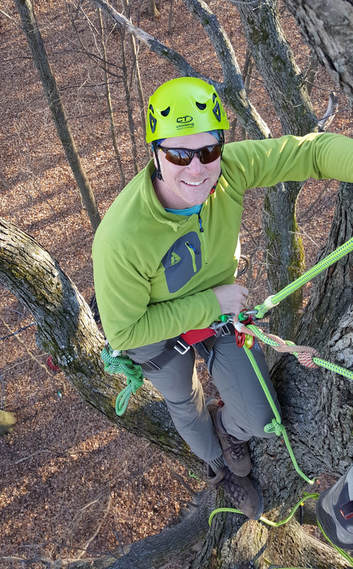 Do you often think back on your childhood with fond memories of seemingly endless summers being spent outside? Do you remember family vacations in National or State parks? Did you enjoy exploring the nearby woods? Did you have a favorite climbing tree? I remember the impact the Smoky Mountains had on me, with their ever changing shades of green fading to blue as the ridgetops seemed to pop up endlessly into the horizon. I can still picture the vast amount of sky surrounding us on an airboat ride through sawgrass marshes in the Everglades. Even with these neat adventures, no summer was complete without our family’s annual camping trips. A large part of who I am today was formed and influenced by these experiences, and possibly more so through my time simply playing outside and spending time in nature. Benefits of Being Outside Growing up, my 5 brothers and I spent most summer days outside. Even in the heat and humidity of southern Florida, we’d much rather be riding our bikes around the neighborhood, exploring the field behind our house, or hiking to the nearby lake to play along the shore and cool off in the water. We often pitched our tents in the backyard simply because we enjoyed the simplicity and freedom of spending time detached from the television and electronic distractions inside (I'm talking about the 1980’s, so think Atari and MTV). If it weren’t for my parents’ willingness to let us ‘rough’ it in the back yard and insistence that we get outside and play, I can only wonder where my life’s journey would have brought me to today. When we were younger, we knew that spending time outdoors was the key to a happy life! Countless studies support this notion, explaining how crucial outside free-play is for us and our children. Free-play allows us to foster our creativity and decision-making skills. Children, in particular, benefit as they are developing motor planning skills and trying to discover their interests. Studies have shown the benefits of spending time in nature is even greater than simply being outside. If you are one who enjoys hiking, camping, hunting, or canoeing, you are probably already aware of nature’s power to make you relax beyond how you feel when you take a walk around your neighborhood. Reduced stress, improved short-term memory, reduced inflammation, improved concentration, sharper thinking, immune system boosts, and improved mental health are some of the benefits that I have experienced firsthand. I wasn't too surprised when I began looking into and reading studies showing the relationship between children who spend less time in nature and the likelihood they experience attention disorders and depression. I have worked outside for a living most of my life. Even if your job has you indoors through the day, neither of us can escape the fact that we need time in nature and free-play. Making Time To Play Outside In the typical progression we call life, things get more complicated. A brief outline of my life is likely quite similar to yours. Now, enjoying our careers, it is quite easy to put in the extra hours. Home repairs pop up. There’s a lawn to mow, meals to make, dishes to clean, garden to weed, and so on. If you have kids, this list expands ten-fold, which can make it seem more difficult to send the kids outside for hours on end. Their schedules are filled with structured activities. You may face pressure from people who have different priorities and approaches for their kids. Kids aside, how about your own well-being? I am sure you still find time for fun, entertainment, and getting outside; but, what does your outside time look like these days? Does it most commonly consist of yard work, relaxing on the back patio, at the kids’ soccer game, or attending one of the many festivals throughout the summer? How much time do you spend in nature? Whatever happened to play time? Do you not have time for either anymore? While I do not play nor spend time in nature nearly as much as I did when I was younger, I know it should be a priority. If the opportunity escapes me for too long, I know it is imperative that I make time as it is as important as proper nutrition. Tree Time I had many favorite climbing trees when I was a kid. In Puerto Rico, there was a magnificent rubber tree (Ficus elastica) at the school playground whose aerial roots and large limbs demanded I swing in the canopy like Tarzan. There was also a rubber tree in our neighbor’s yard in Miami which catered to my later fantasy of living a life like I saw on Swiss Family Robinson. Those who have climbed in or even tended to the more moderate house plant, know how sticky the sap of a rubber tree is. I don’t think my mom ever quite understood that swinging through the trees relied heavily on having sap-layered hands and feet for grip. The sticky arms, legs, clothes and hair were a small price to pay for safety! I had a number of favorite climbing trees through the years. Every one of them provided me a place I could go to be alone. I could read a book, challenge my nerve, take a nap or simply lose myself in the serenity of the treetop. Even today, the benefits I receive from tree climbing often exceed that of other activities primarily because I am outside, breathing fresh air and inhaling the essential oils and compounds emitted by the trees and other components of the natural environment. The further away from concrete & asphalt and the larger the forest ecosystem the tree is growing in, the greater the effect. The climbing process itself heightens your senses and has a profound impact on your brain. You will feel energized once your feet leave the ground, yet you will find peace when you sit back and take in the views. Negative emotions, anxiety and stress will fade away, ushering in positive emotions and a boost in self-confidence and creativity. Feel Better. Be Happy. As much as I love hiking and playing in my gardens, much of my free-play during the summer is climbing trees for fun. Even though I can get in a personal climb during some of my work days, it is the climbing I do outside of work which impacts me the most. There is no right or wrong way to climb a specific tree, which means you are free to explore as you desire that particular day. One rule: stay tied in on rope at all times…the rest you just make up as you go. Nothing compares to how I feel when I am playing out in the woods, high in a tree. Everything comes into balance. Physically, mentally, emotionally. For me it is climbing trees. For you it may be hiking. Don’t wait for a doctor to prescribe it to you. Spend a few hours playing in nature this weekend. We were right all along…playing outside is key to a happy life! |
AuthorAs a G.O.T.C. Recognized Master Instructor & Facilitator, I.S.A. Board Certified Master Arborist, and T.C.I.A. Certified Treecare Safety Professional, Curt has spent over 30 years dedicated to the study and care of trees. Categories
All
Archives
May 2024
|
|

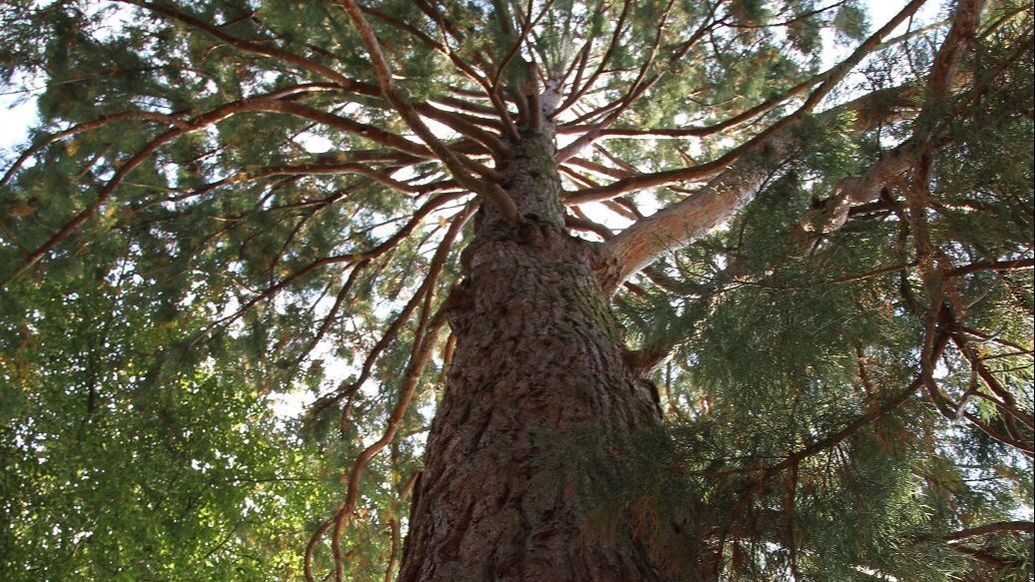

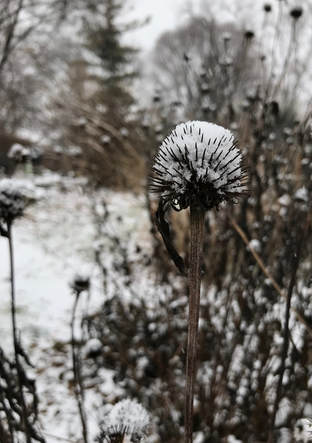
 RSS Feed
RSS Feed
